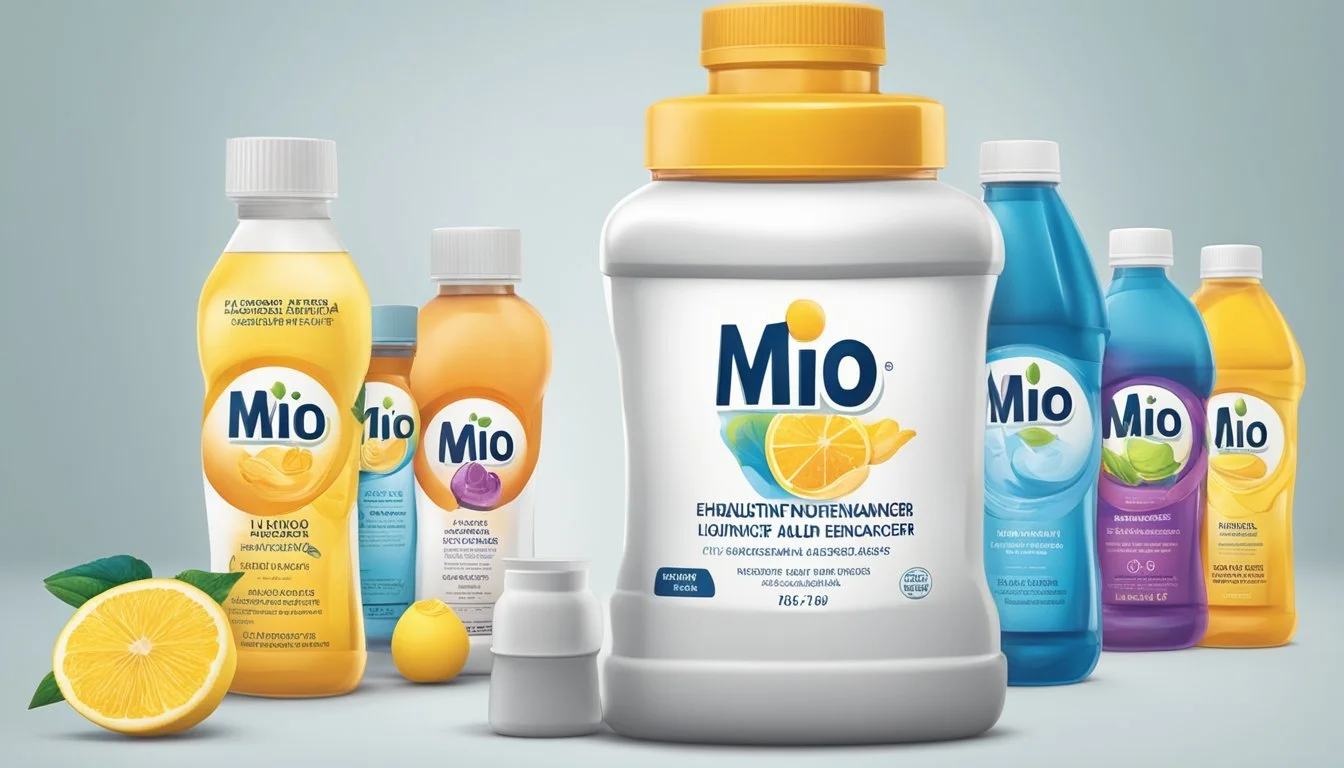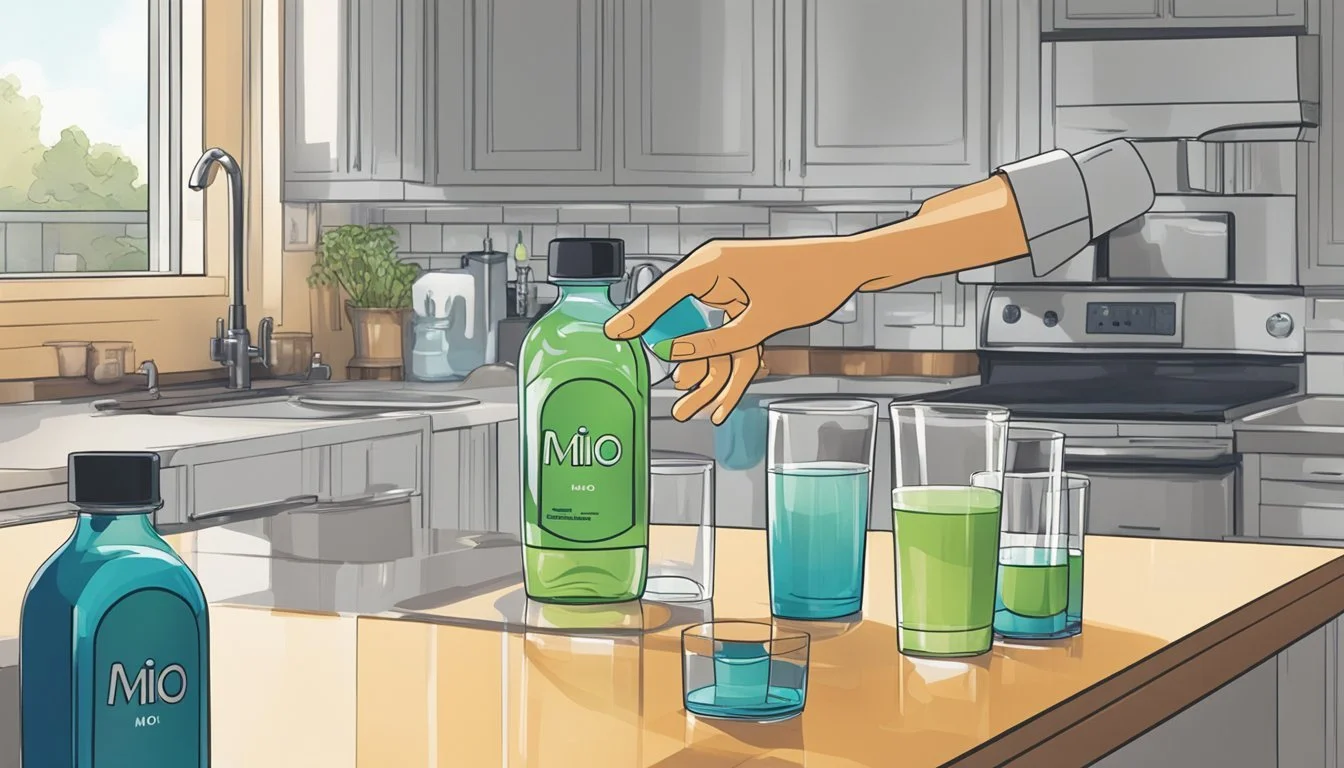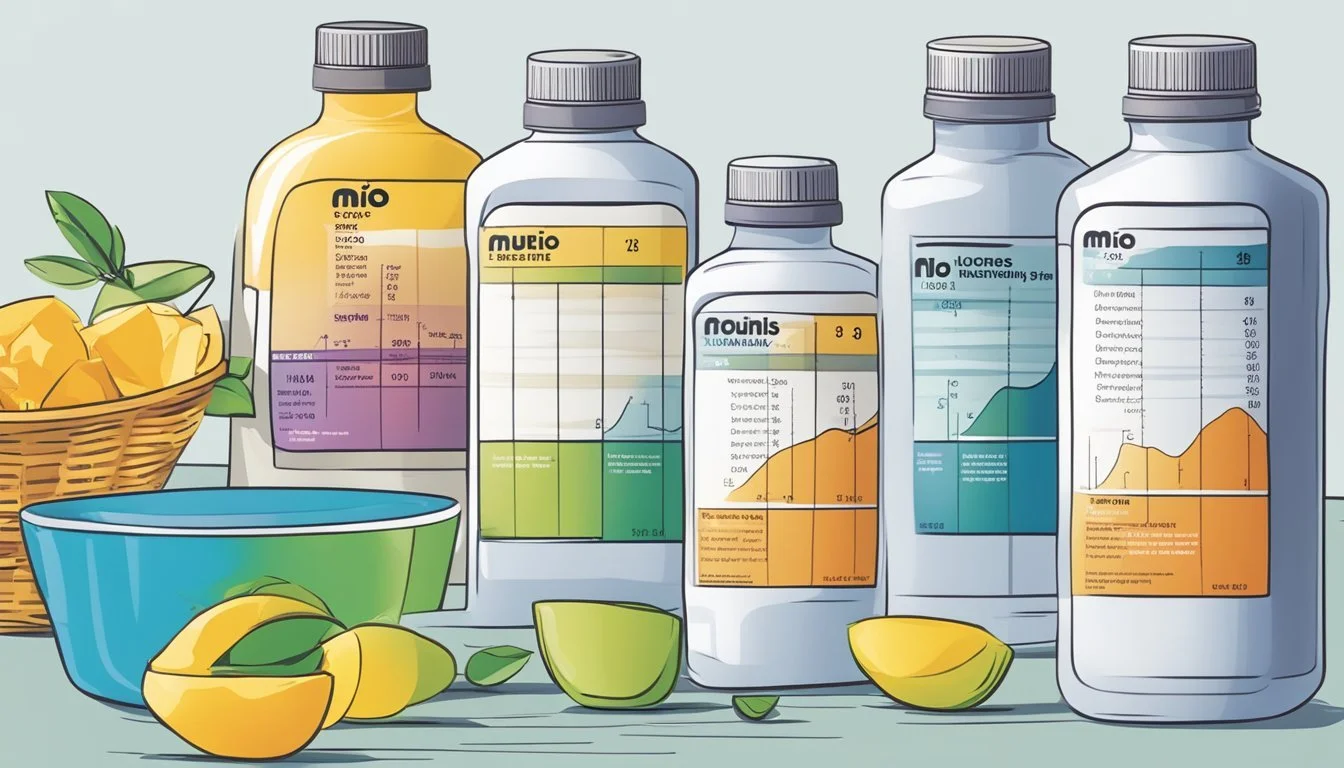How Many Servings of Mio Liquid Enhancer Is Too Much
A Health Guide
MiO Liquid Enhancer has become a popular choice for adding flavor to water, making hydration more appealing. But how much is too much? According to dietitians, consuming more than 2-3 servings of MiO in a day can lead to excessive intake of artificial sweeteners and other additives. This can have potential health implications, especially if you're relying on it for multiple daily refreshment.
Each serving of MiO is typically 1/2 teaspoon, meant to flavor 8 ounces of water. Given its concentrated nature, it’s easy to overpour, resulting in an unintended increase in sweeteners like sucralose and additives such as potassium sorbate. Moderation is key when using MiO to ensure that your hydration habits remain safe and beneficial.
Understanding the ingredients in MiO can also guide how frequently it’s used. Different versions like MiO Energy and MiO Vitamins offer additional elements, including caffeine and B vitamins. Despite these variations, sticking to the recommended serving size ensures you avoid overconsumption, maintaining a balanced approach to flavored hydration.
Understanding Mio Liquid Enhancer
Mio Liquid Water Enhancer is popular for adding flavor, electrolytes, and vitamins to water without additional calories or sugar. This section explores the product, its variants, and the controversial ingredients it contains.
What is Mio Liquid Water Enhancer?
Mio is a liquid concentrate created by Kraft Heinz to add flavor to water. It’s available in a compact, portable 1.62 fluid-ounce bottle. Each bottle claims to provide around 24 servings, and it’s designed to be diluted with at least eight ounces of water.
Mio products come in different flavors targeting various needs. These include hydration, energy boost, and added vitamins. The product’s primary appeal is offering a tasty alternative to plain water, thus encouraging more water consumption.
Different Product Lines
Mio offers several different product lines, each designed for specific purposes:
Mio Original: Focuses on simple flavor enhancement.
Mio Energy: Includes caffeine and B vitamins to boost energy.
Mio Sport: Contains electrolytes for hydration during physical activities.
Each type caters to different consumer needs, making Mio a versatile choice for enhancing water. While Mio Original targets hydrations seekers, Mio Energy appeals to those needing a caffeine boost. Mio Sport helps athletes and active individuals stay hydrated and replenished.
Artificial Sweeteners and Preservatives
Mio contains various artificial sweeteners and preservatives to maintain its flavor and shelf life. Key ingredients include:
Sucralose: A calorie-free sweetener.
Acesulfame Potassium: Enhances sweetness without extra calories.
Sodium Benzoate and Potassium Sorbate: Preservatives to prevent microbial growth.
Although these ingredients help enhance the product’s taste and longevity, some consumers may have concerns about their long-term consumption effects. For instance, sucralose and acesulfame potassium have faced scrutiny regarding possible health impacts, though they are generally recognized as safe by regulatory bodies. People with sensitivities or health conditions should consider these factors before using Mio regularly.
Nutritional Profile and Health Considerations
MiO Liquid Water Enhancer offers a way to flavor water without extra calories or sugar. It can be beneficial for hydration and energy, but it also has potential health risks due to its ingredients.
Caloric Content and Sugar Alternatives
MiO products are calorie-free, making them suitable for those who want to enhance their water without additional calories or carbohydrates. To achieve sweetness without calories, MiO uses artificial sweeteners such as sucralose and acesulfame potassium. These sweeteners do not impact blood sugar levels, making MiO an option for individuals managing their insulin or blood sugar levels.
As per the FDA, these artificial sweeteners are generally recognized as safe. However, some individuals may experience mild digestive discomfort or adverse effects on their gut microbiome when consuming these sweeteners in large quantities.
Vitamins and Electrolytes
Some MiO varieties contain added vitamins and electrolytes. These formulations often include vitamin B3 (niacin), vitamin B6 (pyridoxine), and vitamin B12 (cobalamin). These vitamins play crucial roles in maintaining energy levels, supporting metabolism, and ensuring healthy nerve function.
Electrolyte-enhanced versions of MiO contain potassium and other minerals. Potassium is essential for proper muscle function and maintaining the body's electrolyte balance. For those engaging in physical activities, these enhanced products can help in replenishing lost electrolytes, thereby improving hydration and reducing the risk of muscle cramps.
Potential Health Risks
While MiO provides a convenient hydration solution, overconsumption may lead to potential health concerns. One primary ingredient, sucralose, can disrupt the gut microbiome in certain individuals, potentially leading to digestive issues. Additionally, frequent consumption of artificial colors like Red 40 and Blue 1 might pose risks for those sensitive to these additives.
The presence of preservatives such as potassium sorbate also raises concerns for long-term health impacts, although they are deemed safe in regulated amounts. It's essential to monitor intake to avoid unnecessary exposure to these substances.
Benefits for Hydration and Energy
MiO products can enhance hydration by encouraging increased water intake with their appealing flavors. For those who find plain water unappealing, MiO adds a burst of flavor which may motivate them to drink more water, aiding in maintaining adequate hydration levels.
Energy-focused MiO products often contain caffeine and B vitamins. Caffeine can provide a temporary energy boost and enhance alertness. The B vitamins, particularly B3, B6, and B12, support energy metabolism, helping convert food into usable energy, which can be particularly beneficial during prolonged physical or mental activities.
Recommended Usage
To safely incorporate MiO liquid enhancers into your diet, it is crucial to follow recommended serving sizes and ensure it fits within a balanced nutritional plan. The guidance provided will help optimize hydration and maintain overall health.
Servings and Portion Control
A standard MiO bottle contains 1.62 ounces (48 mL) and is designed to provide between 10 to 24 servings. Each serving size typically involves one squeeze, or about 0.16 to 0.48 ounces, depending on personal taste preference.
Moderation is key when consuming MiO enhancers. While MiO hydrates and flavors water without adding calories or sugar, consuming excessive amounts might lead to an overconsumption of artificial additives such as sweeteners and preservatives.
A prudent approach involves limiting servings to 1-2 squeezes per day to avoid potential negative health impacts. Hydration can still be achieved, even with lower quantities, maintaining the safe and intended use of the product.
Integrating with a Healthy Diet
Integrating MiO water enhancers into a healthy diet requires thoughtful consideration about overall nutrition. MiO offers a zero-sugar, zero-calorie solution which can support increasing daily water intake without added sugars or calories.
However, it's advisable to complement MiO with a diet rich in whole foods such as fruits, vegetables, lean proteins, and whole grains. This approach ensures intake of essential nutrients not found in flavored water enhancers.
Successfully using MiO requires balancing its hydration benefits with a varied nutritional plan, emphasizing natural food sources while enjoying the enhanced flavor of water in moderation. The safe and beneficial use of MiO can help meet daily fluid goals and support overall health when integrated thoughtfully.
Understanding the Ingredients
MiO liquid enhancers contain a mix of artificial sweeteners, colors, and various additives. Each of these components plays a specific role in the product, from flavor enhancement to preservation.
Sweeteners and Their Effects
MiO products utilize various sweeteners like sucralose, stevia leaf extract, and ace-K. Sucralose, derived from sugar, is about 600 times sweeter than sugar and is used to maintain sweetness without adding calories.
Stevia leaf extract is a natural sweetener, extracted from the leaves of the Stevia rebaudiana plant, popular for its zero-calorie content. Meanwhile, ace-K or acesulfame potassium adds another layer of sweetness, being almost 200 times sweeter than sugar. Excessive consumption of these sweeteners can sometimes cause digestive discomfort or an altered gut microbiota.
Artificial Colors and Natural Flavors
MiO enhancers contain artificial colors such as Red 40, Yellow 5, and Blue 1. These colors are used to make the beverages visually appealing but can pose health risks. For instance, Red 40 has been associated with hyperactivity in children by some studies, though the evidence remains inconclusive.
Natural flavors in MiO are derived from various sources to enhance taste. These flavors undergo rigorous testing and are generally recognized as safe by regulatory authorities. The term "natural" does not always signify healthier, as the effects depend on the specific compounds used.
Additives and Preservative Safety
To ensure shelf stability and safety, MiO uses additives like citric acid, sodium, and potassium sorbate. Citric acid acts as a preservative and flavor enhancer, providing a tangy taste. Sodium, in small amounts, helps preserve the liquid but can contribute to daily sodium intake, which should be monitored.
Potassium sorbate is another common preservative that prevents mold and yeast growth. While generally safe, high consumption of preservatives can lead to allergic reactions in sensitive individuals. Ensuring moderate intake within recommended guidelines minimizes potential health risks.
Potential Side Effects and Allergies
Excessive consumption of MiO liquid enhancers can lead to various health issues, ranging from mild side effects to more significant health risks. Additionally, certain ingredients in MiO may trigger sensitivity or allergic reactions in some individuals.
Signs of Overconsumption
Overconsumption of MiO liquid enhancers can pose several health risks. Excessive intake of caffeine from MiO Energy varieties can lead to jitteriness, insomnia, and increased heart rate.
For those sensitive to artificial sweeteners like sucralose, high consumption may cause digestive issues such as bloating and diarrhea. Frequent use can also contribute to tooth decay due to acidic ingredients like citric acid, which can erode enamel.
Artificial food dyes found in some MiO products, such as Red 40 and Blue 1, have been linked to inflammation and may cause adverse reactions in individuals sensitive to these additives.
Sensitivity and Allergic Reactions
Some individuals may experience sensitivity or allergic reactions to certain ingredients in MiO. Natural flavors and preservatives like potassium sorbate and sodium benzoate can be problematic for sensitive individuals, potentially causing skin irritation, stomach pain, or respiratory issues.
Moreover, those with specific food allergies might react to ingredients such as gum arabic or colorants. Symptoms of allergic reactions can include hives, swelling, and difficulty breathing.
Even for those without allergies, the artificial and chemical components of MiO can lead to discomfort or adverse reactions, so moderation is essential.
Consumer Information
MiO Liquid Enhancer offers a wide array of flavors and convenient packaging, making it a popular choice for those who want to add a splash of taste to their water. The variety in flavor profiles and accessibility of the product contribute significantly to its consumer appeal.
Flavor Variety and Personal Taste Preferences
MiO provides a broad spectrum of flavors, catering to different preferences. Popular flavors include lemon, orange, black cherry, lime, and apple. Each flavor adds a unique taste to plain water, allowing users to customize their hydration experience.
For those interested in the health-conscious aspect, MiO offers both original and energy product lines, the latter with added caffeine. These varieties enable consumers to select products based on their dietary preferences and needs. Black cherry and lemon are often highlighted for their balanced flavor profiles.
Packaging, Pricing, and Availability
MiO Liquid Enhancers come in compact, squeezable bottles, making them convenient for on-the-go use. Each bottle typically yields multiple servings, with a serving size being 1/2 teaspoon (2 mL) to flavor 8 ounces (237 mL) of water.
In terms of pricing, MiO is positioned as an affordable option in the market. The average price per bottle ranges from $3 to $5, depending on the retailer and location. MiO products are widely available in most major grocery stores, as well as online platforms, ensuring easy access for consumers.
The availability and competitive pricing make MiO a practical choice for those looking to enhance their water with minimal hassle.
Comparisons with Other Enhancers
In evaluating MiO Liquid Enhancer, it is essential to explore alternatives on the market and compare water enhancers to traditional drinks like sodas and sports drinks. This helps understand the benefits and potential drawbacks of using MiO and similar products.
Alternatives to Mio
There are several alternatives to MiO. Popular options include Crystal Light, Stur, Dasani Drops, and SweetLeaf Water Drops. These products often use different sweeteners such as stevia and stay clear of aspartame, which some people avoid due to health concerns.
Stur and SweetLeaf use natural ingredients and are often marketed as healthier options. Many are low-calorie and offer vitamins or antioxidants, addressing the preference for less artificial components.
Crystal Light and Dasani Drops are also common. They provide a range of flavors, often appealing to those who prefer beverages with little caloric impact. Artificial food dyes and other additives can be present, so it’s advised to check labels if these are points of concern. Reading nutritional labels can help make informed choices.
Water Enhancers vs. Traditional Drinks
Comparing water enhancers like MiO to traditional drinks such as sodas and sports drinks highlights some key differences. Water enhancers are generally much lower in sugar compared to regular sodas, which can reduce the risk of cariogenic effects associated with high sugar intake.
Sports drinks often contain electrolytes and are marketed towards athletic performance. While MiO offers varieties like MiO Sport which include electrolytes, it lacks the carbs often present in sports drinks, making it less suitable for long-duration sports.
Traditional sodas and sports drinks can contain large amounts of sugar, artificial flavors, and dyes. MiO and similar enhancers usually offer more controlled serving sizes, allowing users to manage their intake better. Yet, those sensitive to artificial additives might opt for water enhancers that omit these ingredients.
In conclusion, the choice between MiO, other enhancers, and traditional drinks depends on individual health goals and ingredient preferences.
Environmental and Ethical Considerations
Understanding the environmental impact of MiO's packaging and the ethical sourcing of its ingredients is key to evaluating its overall footprint.
Environmental Impact of Packaging
MiO’s packaging consists of small plastic bottles. These are convenient for portability but pose several environmental concerns. Plastic waste is a significant issue as these bottles are not always recycled properly.
The production and disposal of plastic contribute to pollution and carbon emissions. While MiO bottles are designed to be compact, promoting reuse or recycling can mitigate their environmental impact.
The brand could improve its environmental footprint by exploring eco-friendly packaging options like biodegradable materials or encouraging bottle returns.
Ethical Sourcing of Ingredients
MiO uses various ingredients, including preservatives, dyes, and sweeteners. Ensuring that these ingredients are sourced ethically is important for the integrity of the product.
Ingredients like sucralose and natural flavors should be scrutinized for their impact. Ethical sourcing involves fair labor practices, sustainability, and avoiding harm to ecosystems.
Brands often face criticism if their ingredient sourcing practices are revealed to harm communities or the environment. Transparent sourcing and verified supplier practices can enhance MiO’s reputation. Ethically sourced ingredients contribute to a product that is better for consumers and the planet.








